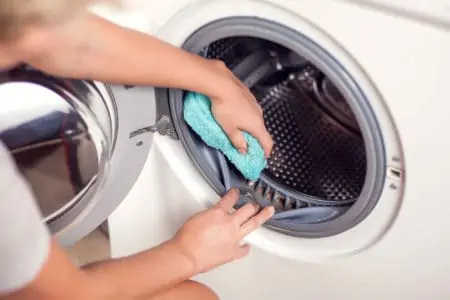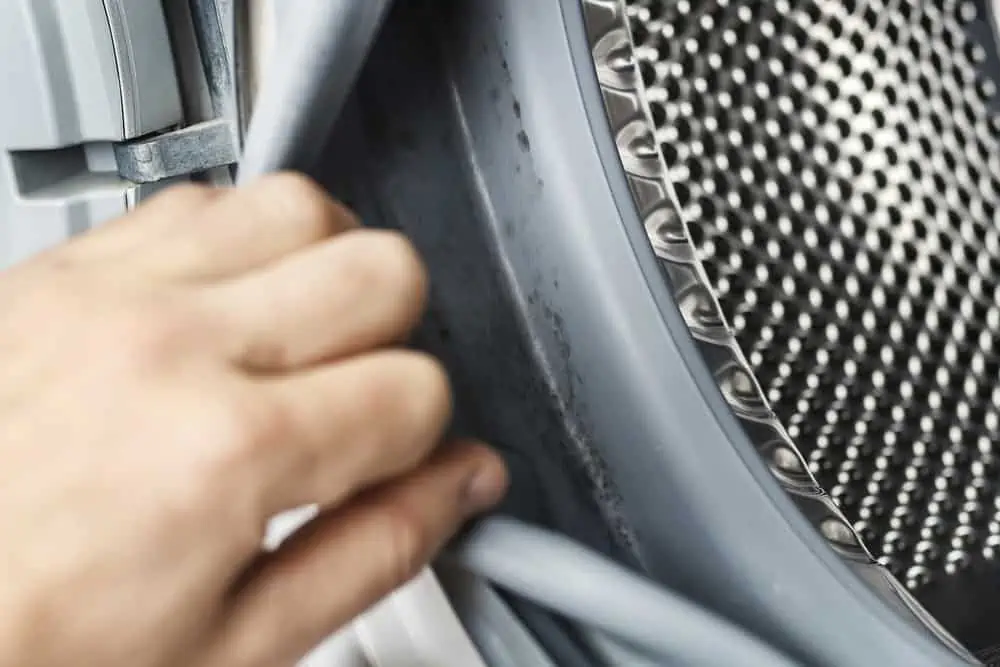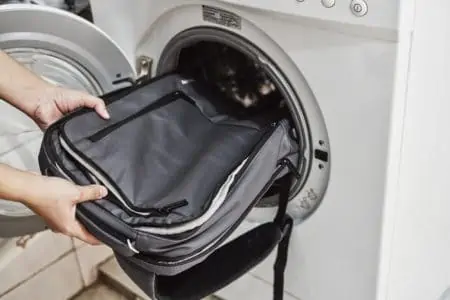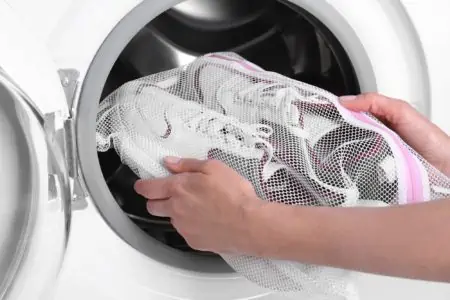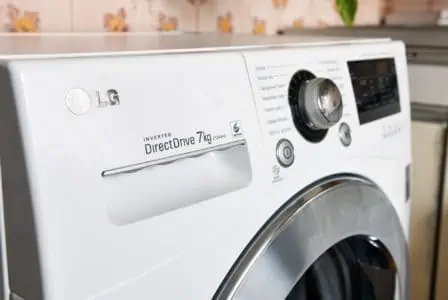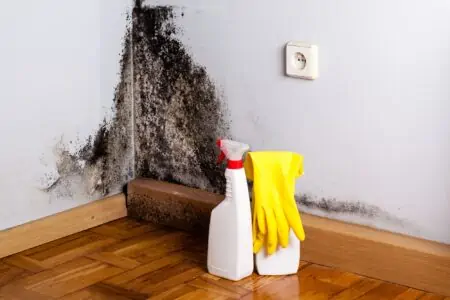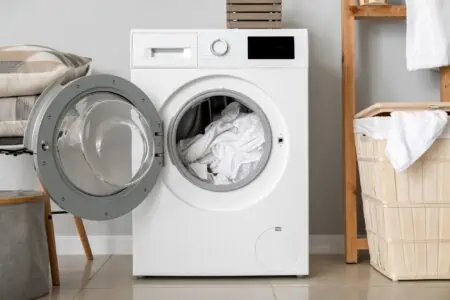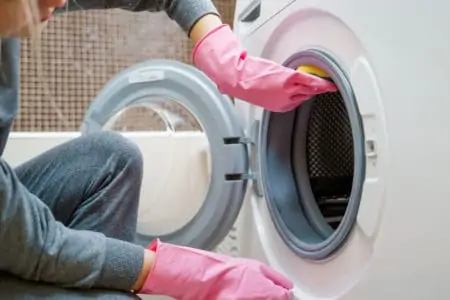Have you noticed mold in your washing machine? This can be a big problem. It can make your clothes smell really bad, but it can also make you sick.
It’s crucial to clean mold from your machine as soon as you notice it. Whether you’ve got a front loader or top loader machine, we have the necessary steps for how to get rid of mold in a washing machine.
Let’s get your machine back to sparkling clean and ensure that your clothes are also smelling fresh and looking spotless!
Key Takeaways
- Mold in washing machines can cause bad smells and health issues, so it’s important to clean it regularly.
- To remove mold, use a diluted bleach or white vinegar solution to scrub affected areas and run a hot cycle.
- Prevent mold growth by keeping the machine dry, using the right detergent, and cleaning it monthly.
- Be sure to wear protective gear and ensure proper ventilation when cleaning mold in your washing machine.
Do All Front Load Washers Have Mold Problems?
Front-load washers are more likely to have mold issues than top loaders.
This is because of the rubber seal and gasket on the door. This seals in water during a washing cycle and doesn’t dry thoroughly. So you have to clean and dry it yourself. The moisture just sits there if you don’t, creating the ideal environment for mold to grow.
That being said, mold can easily grow in top-loading washers, too. These appliances have a metal lip on the door and basin, which users often forget to clean. If you don’t clean these elements regularly, mold can grow.
Can Mold In Washing Machines Make You Sick?
Yes, mold anywhere in your home can cause illness (1). If you have allergies or asthma, you’re even more at risk.
Mold can cause adverse health effects, such as irritation to your eyes, nose, throat, lungs, and skin. Symptoms include sneezing, rash, a runny nose, coughing, red eyes, and more. In worst-case scenarios, you can suffer difficulty breathing or asthma attacks.
Other people at risk include babies, children, older people, people with eczema, and people with a compromised immune system (2).
Black mold, also known as Stachybotrys chartarum, is a greenish-black colored mold (3). It’s quite slimy when it’s wet but powdery when dry (4). It can look splodgy or patchy and tends to grow on wood, drywall, and wallpaper rather than inside washing machines.
Causes of Mold In Washing Machines
Before we get into how to clean mold from your washing machine, it’s important to know how it got there in the first place. That can help you prevent it in the future! Here are five reasons why you might have a moldy machine:
- Moisture in the machine: If you don’t let the machine air dry between cycles, moisture remains in the machine, detergent drawer, and rubber seal. Mold loves to grow in dark, damp places.
- Washing moldy clothes: If your clothes are moldy, which can happen if they sit in the hamper with wet towels for a while, then the mold can easily get into your washing machine. You will need to use a specialized laundry detergent for removing mold spores and deep clean your machine after washing a moldy load.
- Wet clothes sitting: Hanging clean laundry up to dry is a chore we all hate. But if you leave a wet load of laundry in the machine for a while, it can quickly lead to mold.
- Irregular cleaning: You should clean your laundry machine monthly to reduce mold and dirt build-up.
- Wrong detergent: Make sure to use the right detergent for your machine. For instance, if you have an HE machine, make sure you’re using HE detergent. If you use the wrong detergent, you can create too many suds, leading to a lot of residue in your machine. This can cling to moisture longer and, yep, you guessed it, lead to mold.
How to Get Rid of Mold In Washing Machine
Let’s get into an effective method for those wondering how to remove mold in a washing machine.
For a super deep clean, you can use bleach. It’s a great mold remover and killer. If you want to be more eco-friendly, distilled white vinegar can help.
- Time: 3 hours
- Difficulty: Intermediate
Safety Warning
Since mold is an irritant, it’s essential to wear protective clothing like a mask, goggles, and gloves. You should also open doors and windows to improve ventilation. Don’t allow pets, children, or anyone Immuno-compromised into the area.
What You’ll Need:
- Protective gear: mask, goggles, and gloves
- Bleach or white vinegar
- Basin or jug
- Water
- 3-5 microfiber cloths
- Scrubbing brush
- Towel
In Front Loader Washer
1. Prep Area and Make Cleaning Solution
Protect yourself with a mask, goggles, and gloves. Make sure the area is well-ventilated.
Next, make your cleaning solution. If you’re using bleach, dilute it in a jug or basin according to the packaging instructions. This is usually about one cup of bleach per gallon of water. A smaller ratio would be about 50 milliliters of bleach per liter of water.
If using distilled white vinegar, make a cleaning solution with a 1:1 ratio with water.
Caution
Never mix bleach and white vinegar. Choose one or the other for every step of this cleaning process. Combining these two ingredients can create lethal chlorine gas (5).
2. Soak Cloths and Apply to Mold
Soak a few microfiber cloths in your cleaning solution and apply them to the moldy areas of the machine. For example, you might want to stuff them in the rubber gasket so that all areas are soaking in the solution. Leave for 20-30 minutes.
3. Scrub the Moldy Areas
Dip a scrubbing brush in your cleaning solution and scrub the moldy areas well to remove the loosened mold and mildew. You may need to apply some elbow grease!
Repeat steps two and three if necessary until the mold is visibly gone.
4. Run a Hot Cycle
Toss the dirty rags into the washing machine. Pour ½ cup of bleach or one cup of distilled white vinegar into the detergent drawer. Choose the hottest cycle and run the washing machine.
5. Clean Lint Filter and Drain
When the machine is finished, remove the dirty rags and dry them in the tumble dryer or on a clothesline.
Leave the washing machine door open to air dry.
Empty your lint filter into a basin or jug. Now remove the drain. Run it under warm water to remove dirt. Using dish soap, scrub the drain filter to get rid of mold and dirt. Rinse well before returning to the machine.
6. Spray Machine Clean
Spray the body of the washing machine, door, gasket, and inside with a multi-purpose cleaner. Wipe with a microfiber cloth to complete the job.
7. Dry Machine
In Top Loader Machine
1. Wear Protective Gear
Just like you would with a front-loader, you should wear protective equipment. This includes your gloves, mask, and goggles. Open a window for ventilation.
2. Fill Machine With Water and Cleaner
Set the machine to a hot cycle and let the drum fill up with hot water. When it’s finished filling, pause the cycle. Add ½ cup of bleach or one cup of distilled white vinegar. Remember never to combine these two cleaners. It’s super dangerous!
Let the water soak for one hour before continuing the wash cycle.
3. Clean Machine While Water Is Soaking
Dip a microfiber cloth into the hot water that’s soaking. Scrub the entire machine, all around the top and under the lip, where mold likes to hide. Pay attention to nooks and crannies. Scrub well. You can swap it out for a scrubbing brush if a cloth doesn’t cut it.
4. Run the Cycle
Shut the washing machine lid and let the cycle continue. This gives the bleach a chance to deep clean the drain and drum.
5. Dry Machine
Take a towel or microfiber cloth and wipe down the machine and drum. Make sure it’s nice and dry, which can prevent mold and mildew build-up between uses.
In Detergent Dispenser
We can’t forget the importance of cleaning the detergent dispenser. Mold likes to live here, too. Never skip this step. If you have a moldy drawer, then the water and detergent will drag the mold into your clothes every time you run a cycle.
- Remove drawer: Take the drawer out of the machine and put it in your sink. Clean this separately. Do this before the above steps.
- Fill sink: Fill your sink with warm water and a couple of cups of distilled white vinegar or one cup of bleach. Let the drawer soak for up to one hour.
- Scrub clean: Use a scrubbing brush or sponge to scrub the drawer of the loosened mold, dirt, and detergent build-up.
- Rinse: Drain the water from the sink and rinse the drawer under clean water for a few minutes.
- Fill a jug with cleaning solution: Dilute bleach or distilled white vinegar in a jug with water. Dip a cloth or cleaning brush into the solution and scrub around the space where your drawer fits. Make sure to get into all the nooks, crannies, seals, and hinges where mold might be hiding.
- Dry: Use a towel to dry the detergent drawer and the gap where the drawer goes.
Tips For Preventing Mold Growth In Washers
Now that you know how to clean mold from your washing machine, you can almost wave goodbye to mold issues once and for all. But we have one more thing to remind you of: prevention.
It’s important to prevent mold from growing in your washer in the first place. If you stay on top of this, you’ll never have an excessive build-up of mold. It saves you from spending an entire Saturday afternoon cleaning your machine!
- Keep the machine dry: After each wash, dry the washing machine. You can let it air dry by leaving the door open, or you can manually dry it with a towel. Moisture likes to fester in damp, dark places, so make sure you remove moisture from the rubber seal too.
- Use the right detergent: Don’t use standard detergent in a high-efficiency washer. This can cause soap build-up, making it harder for your machine to rinse water effectively. Excess water means a higher chance of mold.
- Add a fan to your laundry room: Add an extractor fan or air-conditioner to improve airflow in your laundry room. You can also leave the windows open, but this may not be fun in the winter!
- Check dryer vent: If you have a tumble dryer, keep the vent clean and tight. Otherwise, it can leak moist air into the laundry room and lead to mold issues.
- Deep clean machine monthly: You should deep clean your washing machine every month to stay on top of dirt and mold build-up.
- Remove wet clothes immediately: When a cycle is finished, transfer the clothes to the dryer or clothesline as soon as possible.
FAQs
Bye, Bye, Mold!
With these steps, you can get rid of mold in your washing machine without the help of a professional.
Always make sure to wear protective equipment and provide adequate airflow for your health and wellbeing.
While you can use distilled white vinegar for a more eco-friendly clean, bleach is best for killing and cleaning mold.
If the methods don’t work for cleaning your rubber gasket, your manufacturer can provide you with a new one.
